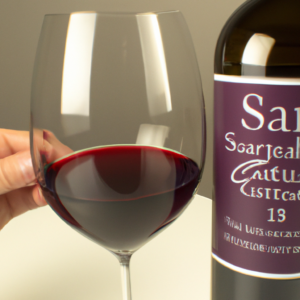Ullage is a wine term that refers to the empty space between the wine and the cork in a wine bottle. The term is used to describe the level of wine in the bottle and can be an indicator of the wine’s age and storage conditions.
In winemaking, ullage is an important factor to consider as it can affect the quality and longevity of the wine. Ullage can be caused by a number of factors, including evaporation, leakage, and poor cork quality. The level of ullage in a wine bottle can be a useful tool in determining the condition of the wine and its potential for aging.
The level of ullage in a wine bottle is often used as an indicator of the wine’s age. In general, the higher the ullage, the older the wine. This is because over time, wine evaporates through the cork, causing the level of wine in the bottle to decrease. However, it is important to note that the rate of evaporation can vary depending on the storage conditions, so the level of ullage should not be relied upon as the sole indicator of the wine’s age.

The level of ullage can also be an indicator of the wine’s storage conditions. If a wine bottle has a low level of ullage, it may indicate that the wine has been stored on its side or in a humid environment, which can cause the cork to expand and create a tight seal. On the other hand, a high level of ullage may indicate that the wine has been stored upright or in a dry environment, which can cause the cork to dry out and allow air to enter the bottle.
Ullage can also have an impact on the quality of the wine. When the level of wine in a bottle is low, there is more air in the bottle, which can lead to oxidation and spoilage. This is because oxygen can react with the wine and cause it to develop off flavors and aromas. In addition, high levels of ullage can cause the cork to dry out and become brittle, which can result in cork taint or leakage.
To prevent the negative effects of ullage on wine, winemakers take steps to minimize the amount of empty space in the bottle. This can include using high-quality corks, storing the wine in a cool and humid environment, and filling the bottle to the top to reduce the amount of air in the bottle.
In the context of wine auctions, the level of ullage in a wine bottle can have a significant impact on the value of the wine. In general, wines with low levels of ullage are considered to be in better condition and are therefore more valuable. However, it is important to note that the value of a wine is influenced by many factors, including provenance, storage conditions, and the reputation of the producer.
In conclusion, ullage is an important factor to consider in winemaking and wine storage. The level of ullage in a wine bottle can be an indicator of the wine’s age and storage conditions, as well as its potential for aging. Winemakers take steps to minimize the amount of empty space in the bottle to prevent the negative effects of ullage on the quality of the wine. When purchasing wine, the level of ullage in the bottle can be a useful tool in determining the wine’s condition, but should not be relied upon as the sole indicator of the wine’s age or value.
Americans consumed a total of 327 million 9-liter cases of wine in 2019, which equates to approximately 3.9 billion bottles of wine. This represents a slight increase from previous years and reflects a trend of growing wine consumption in the United States.
Tags, Tags, #hashtags, Tags